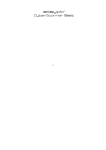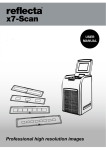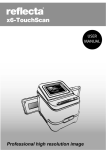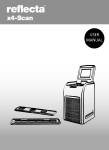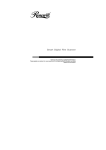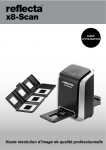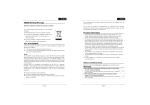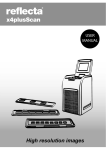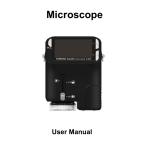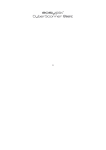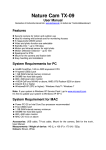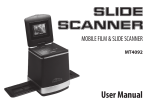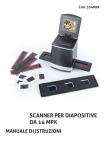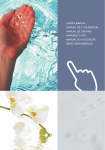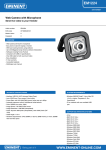Download User Manual
Transcript
User Manual -1- Table of Contents 1. Precautions…………………………………..……... 2 2. Preparation……………………………………..…… 6 Accessories…………………...……………... 6 Product details…………………………..…… 7 3. Install The Software…………………………..……. 8 Install the Software on Windows…..…..……. 8 Install the Software on Mac…….………….… 9 4. How to use the Film/Slide holder………………..…. 10 5. Connecting up the busbi Digital Image Copier.……11 6. Viewing pictures on a computer...…………………. 12 Viewing pictures on Windows………………... 12 Viewing pictures on a Mac…………………. 16 7. Editing Pictures / Photo Editing Tools................. 20 Adjust…………….………………………….... 20 Retouch…………..…..………………………. 24 Clipboard…………………………………..….. 26 8. Appendix……………………………………………….27 Specifications………………………………….. 27 Trouble Shooting and Support.…….…………28 System Requirements………………………….30 -2- EN Welcome Thank you for purchasing the busbi Digital Image Copier. Please take a moment to read through this manual. 1. Precaution Before using the busbi Digital Image Copier, please ensure that you read and understand the safety precautions described below. Always ensure that the image copier is operated correctly. Do not operate the busbi Digital Image Copier in an unsafe environment or where operation of such a device is restricted. Do not open the case of the busbi Digital Image Copier or attempt to modify the busbi Digital Image Copier in any way. High-voltage internal components create the risk of electric shock when exposed. Maintenance and repairs should be performed only by authorised service providers. Keep the busbi Digital Image Copier away from water and other liquids. Moisture on the device can create the risk of fire and electric shock. Keep the busbi Digital Image Copier and its accessories out of the reach of children and animals to prevent accidents or damage to the image copier. -3- If you notice smoke or a strange odor coming from the busbi Digital Image Copier, turn the power off immediately. Take the busbi Digital Image Copier to the nearest authorized service center for repair. Never attempt to repair the busbi Digital Image Copier on your own. Use only the recommended power accessories. Use of power sources not expressly recommended for the busbi Digital Image Copier may lead to overheating, distortion of the equipment, fire, electrical shock or other hazards. The busbi Digital Image Copier may become slightly warm during use. This does not indicate malfunction. If the exterior of the busbi Digital Image Copier needs cleaning, wipe it with a soft, dry cloth. -4- EN CAUTION To comply with the limits for a Class B digital device, pursuant to Part 15 of the FCC Rules, this device must only be installed on computer equipment certified to comply with the Class B limits. -5- 2. Preparation EN Accessories Image Copier QSG 135 Slide Holder CD 135 Negative Film Holder 110 Film Holder (Optional) Clean Brush -6- Product Details Note: We strongly suggest using the supplied Clean Brush to insert into the image copier slot and clean the glass surface periodically to produce a clear image. Please make sure your film negatives/ mounted slides and cover trays are clean before inserting into the copier as well. Dust or dirt from the negatives and cover trays will affect the quality of your scanned images. -7- 3. Install the Software This busbi Digital Image Copier is supported by Microsoft / Mac UVC (Universal Video Class) and Plug & Play technology. Therefore, it does not need a separate driver. To use the busbi Digital Image Copier you must install ArcSoft MediaImpression software in advance. This software is located on the CD. Installing the Software on Windows OS computer 1. Insert the installation CD into the CD-ROM drive and the installation CD menu should appear. 2. When you see the following screen, choose “ArcSoft MediaImpression” to install the software. 3. Follow the on-screen instructions. 4. On Customer Information, please refer to the sticker with SN no. on the CD paper case for License Key. -8- EN 5. The installed software will automatically create a MediaImpression logo on your desktop. 6. Restart the computer. Installing the Software on Mac OS computer 1. Insert the installation CD into your computer‟s CD-ROM drive and click CD icon. 2. Click ”MediaImpression Installer” 3. Follow the on-screen instructions. 4. On Customer Information, please refer to the sticker with SN no. on the CD paper cover for License Key. -9- 4. How to use the Film/Slide holder 1. Open the negative/ positive slide holder as Illustrated. 2. Place a negative film / positive slide / 110 film into holder as shown. 3. Close the holder and ensure the holder close fully. -10- EN 5. Connecting up the busbi Digital Image Copier 1. Plug the USB cable of the Image Copier into your computer‟s USB 2.0 port. Once connected the Power LED light will turn on. 2. Insert the loaded film/ slide holder properly into the slot according to the triangular signs as shown. IMPORTANT: INSERTING HOLDERS INCORRECTLY MAY DAMAGE YOUR IMAGE COPIER (Insert through front entrance) -11- 6. Viewing Pictures on a computer Acquire Picture using Windows 1. Click on the MediaImpression icon on the desktop as shown below. 2. Click “Acquire”. Select “Acquire from Film Scanner”. -12- EN 3. Define the „save as‟ settings: a) There are two formats JPG or TIFF for setting. b) There are four quality levels (Highest/ High/ Normal/ Low) for selection in JPG format. c) Select the location to save your image. -13- d) There are two film sizes (135 film, 110 film) to EN choose from. You are advised to select 135 film as most users do not have 110 film. The 110 Film Holder is an optional accessory. e) Select the film type you are going to scan. f) Click “OK”. -14- 4. Capturing images You will see the image to be captured in the live view window. Adjust the holder to avoid any dark edge appearing in the live view window. Any dark edges will be captured if they appear in the live view. If the dark edge is on top or bottom when capturing the image, tilt the device left or right to capture the image correctly. Click “Capture” to save image to your computer. 5. Move the film holder and press “Capture” for the next film scan. -15- Viewing pictures using a Mac Click on the MediaImpression icon on the desktop as shown below. 1. Click “Acquire”. Select “Acquire from Film Scanner”. -16- EN 2. Define the „save as‟ settings: a) There are two formats JPG or TIFF for setting. b) There are four quality levels (Highest/ High/ Normal/ Low) for selection in JPG format. c) Select the location to save your image. -17- d) There are two film sizes (135 film, 110 film) to EN choose from. You are advised to select 135 film as most users do not have 110 film. The 110 Film Holder is an optional accessory. e) Select the film type you are going to scan. f) Click “OK”. -18- 3. Capturing images You will see the image to be captured in the live view window. Adjust the holder to avoid any dark edge appearing in the live view window. Any dark edges will be captured if they appear in the live view. If the dark edge is on top or bottom when capturing the image, tilt the device left or right to capture the image correctly. Click “Capture” to save image to your computer. 4. Move the film holder and press “Capture” for the next film scan. -19- 7. Editing Pictures Click on the picture you wish to edit, and then use the ArcSoft tools to edit. Photo Editing Tools The Photo Editing module includes a complete set of photo enhancement, editing and retouching tools. The windows can be stretched to provide a larger view of the chosen image. Double click the module‟s tool bar to maximize the window. In addition to this large workspace, the Photo Editing module includes five distinct sets of tools: 1. Adjust 1.1 Enhance The Enhance feature includes two types of tools: - Auto Enhance Click the “Auto Enhance” button to improve the overall quality of your pictures with a single click. - Manual Fix For precise image enhancement control, adjust the brightness, contrast and sharpen sliders. How to enhance a photo manually: 1. Move the sliders to adjust the level of brightness, contrast, saturation, hue and sharpness. 2. Use the zoom slider to get a closer look at how the adjustment affects the photo. 3. Click “Apply” if you like the result. Click “Cancel” if you do not. -20- EN 1.2 Color This feature is designed to fix digital photos that have incorrect colors or appear too dark. It is useful for fixing scanned versions of old pictures that have become faded. How to fix the color of a picture: 1. Drag the color balance sliders to make the photo color appear more natural. Add red or yellow to make the photo warmer. Add blue or green to make the photo cooler. 2. Drag the Lighter/Darker slider to the left to reveal details hidden in a dark photo or to the right to make a faded photo look new again. 3. Click “Apply” if you like the result. Click “Cancel” if you do not. 1.3 Red-Eye This feature makes it easy for you to fix red-eye; a common problem in flash photography. There are two ways to fix red-eye: - Auto Fix 1. Simply click the “Fix Red-Eye” button to automatically remove Red-Eye issues.. 2. If not all of the red-eyes are fixed, use the “Click to Fix” method. - Manual Fix 1. Use the zoom slider on the toolbar to zoom in on the photo. 2. Drag the small white box inside the zoom navigator -21- EN and move over a red eye. 3. Place your cursor directly over the red eye and left-click. 4. Repeat the process until all the red eyes are fixed. 5. Click “Undo” if you make a mistake or do not like the result. 1.4 Crop This feature enables you to trim photos for a dramatic effect or cut off the distracting parts of a picture. How to use the crop function: 1. Choose the crop orientation (portrait or landscape). 2. Select a fixed proportion for the crop rectangle (4:6, 5:7, 8:10) or choose “Custom” if you want to use a different ratio. 3. Resize the crop rectangle by clicking and dragging the red lines. 4. Move the crop rectangle into position by clicking and dragging inside the red box. 5. Click “Crop”. The area inside the rectangle will be kept, the area outside will be trimmed away. 6. Click “Undo” if you make a mistake or do not like the result. 1.5 Straighten This feature enables you to fix photos that appear to be tilted. -22- How to use Straighten: 1. Move the slider (or click the rotate buttons) until the photo appears straight. 2. Use the superimposed grid lines for vertical and horizontal reference. 3. Click “Apply” if you like the result. Click “Cancel” if you do not. 1.6 Blur Background This feature can be used in a subtle way – to tone down un-important background details, or for dramatic effect- by making the main subject of a photo “pop out” of the picture. How to use the Blur Background function: 1. With your cursor, trace a line around the person or object you want to strand out. When you release the mouse button, the area outside the traced line will become slightly blurred. 2. Drag the first slider to make the transition between the blurred and non-blurred area sharp or smooth. 3. Drag the second slider to increase or decrease the amount of blur. 4. Click “Apply” if you like the result. Click “Cancel” if you do not. Saving Your Results When you are finished editing a photo, click “Save as” to save your results. You can choose to overwrite the original file or save as a new one. Click “Close” to exit the Photo Editing Module. -23- 2. Retouch 2.1 Healing Brush The Healing Brush is good for fixing dust, scratches and removing skin blemishes. How to use the Healing Brush to fix a skin blemish: 1. Establish a source point for the Healing Brush by holding the Shift key and clicking on an area of the skin that is close in color and texture to the area you want to heal. 2. Use the zoom control to zoom in on the blemish. 3. Adjust the size of the healing brush so the cursor (circle) is only slightly larger than the blemish. 4. Paint over the blemish. The area will be concealed. 5. Click “Undo” if you make a mistake or do not like the result. 2.2 Clone The Clone tool is good for the removing unwanted elements from a photo. It can also be used for a fun effect, like moving a nose from one person to another. How to use the Clone tool to remove a telephone pole from the background of a photo: 1. Establish a source point for the Clone tool by holding the Shift key and clicking on an area of the sky that you want to use to paint over the telephone pole. 2. Adjust the brush size so the cursor (circle) is only slightly larger than the widest part of the telephone pole. -24- EN 3. Click and hold your mouse button and carefully paint over the telephone pole. Do not release the mouse button until the job is done. The sky will be cloned into place. 4. Click “Undo” if you make a mistake or do not like the result. 2.3 Lighten/Darken The Light/Darken tool is good for adjusting specific areas of a photo. 2.4 Smudge Simulate the smearing of wet paint. Please click and drag the sliders to change the brush size and sharpness. 2.5 Sharpen Sharpen blurry areas. Click and drag the sliders to change the brush size and transparency. 2.6 Blur Smooth out rough areas. Click and drag the sliders to change the brush size and intensity. -25- EN 2.7 Paint Brush Allows you to “paint” on your image when you click and drag the mouse. Click and drag the sliders to change the brush size and transparency. 2.8 Line Draw a straight line in the photo. Click and drag the sliders to change the line width and transparency. 2.9 Eraser Simulate an eraser, removing the image painting by Paint Brush and Line tools from your photo. Click and drag the sliders to change the eraser size and effect. 3. Clipboard Create different versions of your pictures by selecting Rectangular, Elliptical, Freehand, Magic wand and Magnetic. Note: For more detailed information, please refer to the [Help section] of program. -26- 8. Appendix Specifications Image Sensor 1/2.5” 5 mega CMOS sensor, 5 mega pixels Lens Specification F=6.4, f=12.36mm, 2G2P, field of angle=26º Color Balance Automatic Exposure Control Automatic Supported film sizes 135mm film (36mm x 24mm) auto cropping 110 film (17mm x 13mm) Supported film types Color Negative Film (135 & 110) auto converting Black & White Negative Film Focusing Fixed Focus PC interface USB 2.0 Scan High Resolution 4.3M equal to 1,800 dpi (enhances to 3,600 dpi via interpolation) Data Conversion 24 bits R.G.B color channel (48 bits color depth option in MediaImpression) Image Format 135 Film 3:2 ratio 110 Film 4:3 ratio Light Source Back Light 3 white LED Support Microsoft Windows XP, System Requirements Vista, Windows 7 Mac OSX 10.5 or above Power From USB port Dimension 165.7(H) x 104(W) x 90(L) mm Bundled Software ArcSoft Medialmpression Specifications are subject to change without prior notice. -27- Trouble Shooting and Support Issue My computer does not recognize the image copier. I get a Windows message that reads "device not recognized" My installation disc will not auto start My image copier works ok, but some of my slides or negatives look overexposed Possible cause Image Copier is not plugged into a high-speed USB (2.0) port. Resolution There may be a problem with software CD. Check to see if your CD drive is operating properly. If possible check another computer to see if the disc is recognised. Some “Anti Virus” software may block the auto start please install manually. The image copier self adjusts to your slide/negative exposure. Wait for the live view window to stop adjusting for exposure and then click “Capture” to get the image. Check your slides or negatives to see if they may have been overexposed when originally developed. You may use the MediaImpression software to adjust or improve the image quality. There may be a problem with your CD drive. Auto exposure varies according to your computer configuration. -28- Your computer must have a USB 2.0 connection to communicate with the image copier. Check to see if USB 2.0 is available on your computer. If you do not have USB 2.0 on your computer, you can upgrade your USB ports. Issue I found black edges in preview mode I found black edges when viewing the photo Your software will expire in XX days. My Mac computer does not work with the copier. Possible cause Slide holder may not be central/correct position Film/Slide size tolerance limitations You downloaded the trial software from ArcSoft website. Your Mac. OS is version 10.4 or below. Resolution Tilt the scanner left or right, slide will move into correct position. Check the preview photo again. Crop the photo using the MediaImpression software. Please refer to this manual, “Editing pictures - Section 1.4: Crop” Uninstall the downloaded MediaImpression and install the software again from the CD. Some older Mac 10.4 version does not support UVC. Please upgrade to its latest version 10.4.11 or above. Technical Support For further queries, please see the support page on the busbi website; www.busbi.biz -29- PC System Requirements ® Pentium P4 1.6GHz or equivalent AMD Athlon Free USB2.0 port 512MB RAM 500MB free hard disk space 1024 x 768 pixel color monitor CD-ROM drive ® Windows XP Service Pack II / Vista™, 32/64 bits Windows 7 Mac System Requirements PowerPC G5 or Intel Core Duo processor recommended Free USB2.0 port 768MB RAM 500MB free hard disk space 1024 x 768 color monitor CD-ROM drive Mac 10.5 or above This symbol on the product or in the instructions means that your electrical and electronic equipment should be disposed at the end of its life separately from your household waste. There are separate collection systems for recycling in the EU. For more information, please contact the local authority or your retailer where you purchased the product. This product is CE certified. CMS Peripherals Limited, 24 Scrubs Lane, London, NW10 6RA -30-






























